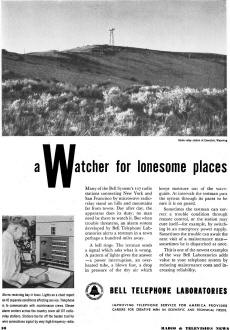|
This 1952-era promotion for
Bell Telephone Laboratories describes what is essentially an early Supervisory
Control and Data Acquisition (SCADA)
system; it's just that the term had not been coined yet. SCADA systems uses
sensors of various types to monitor the status of critical parameters and report
it back to a remote location via telephone, cable, or radio links. It reduces or
eliminates the need for personnel to be present unless immediate human
interaction is required to handle an adverse situation. Electrical distribution
stations, gas and oil lines, telephone switching installations, etc. SCADA
systems are typically monitored by computers and in most cases log events and
initiate required actions; however in some scenarios a human monitors the SCADA
information and control processes manually. Nowadays, most people probably
control their own personal SCADA systems via their smartphones or other Web
connected devices. Your remotely controlled webcams, adjustable thermostats, and
light bulbs, home security systems, gas grilles, and all other sorts of IoT
devices are forms of SCADA.
Bell Telephone Laboratories Ad
 Radio-relay station at Evanston, Wyoming Radio-relay station at Evanston, Wyoming
a Watcher for lonesome places
Many of the Bell System's 107 radio stations connecting New York and San Francisco
by microwave radio-relay stand on hills and mountains far from towns. Day after
day, the apparatus does its duty; no man need be there to watch it. But when trouble
threatens, an alarm system developed by Bell Telephone Laboratories alerts a testman
in a town perhaps a hundred miles away.
A bell rings. The testman sends a signal which asks what is wrong. A pattern
of lights gives the answer - a power interruption, an over-heated tube, a blown
fuse, a drop in pressure of the dry air which keeps moisture out of the waveguide.
At intervals the testman puts the system through its paces to be sure it is on guard.
Sometimes the testman can correct a trouble condition through remote control,
or the station may cure itself - for example, by switching in an emergency power
supply. Sometimes the trouble can await the next visit of a maintenance man - sometimes
he is dispatched at once.
This is one of the newest examples of the way Bell Laboratories adds value to
your telephone system by reducing maintenance costs and increasing reliability.
Alarm-receiving bay in town. Lights on a chart report on 42 separate conditions
affecting service. Telephone is to communicate with maintenance crews. Eleven alarm
centers across the country cover all 107 radio-relay stations. Stations too far
off the beaten trail for wire connections signal by very high frequency radio.
Bell Telephone Laboratories
Improving Telephone Service for America Provides Careers for Creative Men in
Scientific and Technical Fields.
Posted April 26, 2021
| Bell Telephone
Laboratories Infomercials |
-
Bell Telephone Laboratories - Time Domain Reflectometry - December 1948 Popular
Science
-
The Future Holds Great Promise - August 1949 Popular Science
-
Waveguide: 7/47 Popular Mechanics
-
Wire Wrapping - 10/1953 Popular Science
-
X-Rays, 4/60 Radio-electronics
- The Battle of
the Atoms, 4/1948 Radio News
-
The Transistor, 6/1952 Radio-Electronics
- 90-Mile Laboratory
for Telephone and Television, 6/1945 Radio News
-
Wire-Wrap, 10/53 Radio-Electronics
-
EDT Crystals, 10/47 Radio-Craft
- Germanium Refining,
5/54 Radio & TV News
- Crystal Timekeeping,
1/46 Radio News
- Transatlantic
Cable, 11/56 Radio & Television News
- Pipe Circuits,
11/48 Radio & Television News
-
Coaxial
Electron Tube, 6/54 Radio & Television News
- Thermocompression
Wire Bonding, 3/58 Radio News
-
Radio Relay Stations, 8/52 Radio & Television News
- Isolators,
6/56 Radio & Television News
- Punch
Cards, 3/55 Radio & Television News
-
Over-the-Horizon
Communications, 10/55 Radio & Television News
- Memory
Devices, 2/58 Radio & TV News
-
Adventure in Silicon, 5/55 Radio & Television News
- Pipes of Progress,
6/55 Radio & Television News
-
Project Echo, 11/60 Electronics World
|
-
Testing Phones - November 1947 Popular Science
-
Jacques Bernoulli, February 1960 Radio-Electronics
-
Type-O Carrier System, October 1952 Radio-Electronics
-
Electron Microscope, 4/1952 Radio-Electronics
-
Thermistor, 11/1946 Radio-Craft
-
Germanium Crystal, 1/1954 Radio-Electronics
-
Lens
Antenna, 5/46 Radio-Craft
- Quality Control, 6/46
Radio News Article
- Transcontinental
Radio-Relay, 10/51 Radio & TV News
- Solar
Battery, 7/54 Radio & Television News
-
Germanium Transistors, 1/54 Radio & Television News
- Cavity
Magnetron, 10/45 Radio News
-
The Cableman, 10/49 Radio & Television News
-
Coaxial Cable, 12/49 Radio & Television News
-
Tin
Whiskers, 12/55 Radio & Television News
- Relay
Contact Inspection, 7/55 Radio & Television News
- Transistor's
10th Anniversary, 6/58 Radio & Television News
-
Wire
Wrapping, 10/53 Radio & Television News
- Junction
Diode Amplifier, 11/58 Radio News
-
Nobel Prize Winners, 2/57 Radio & Television News
-
Diode Speeds Voices, 8/58 Popular Electronics
-
Microwave Relays, 7/59 Electronics World
|
|









